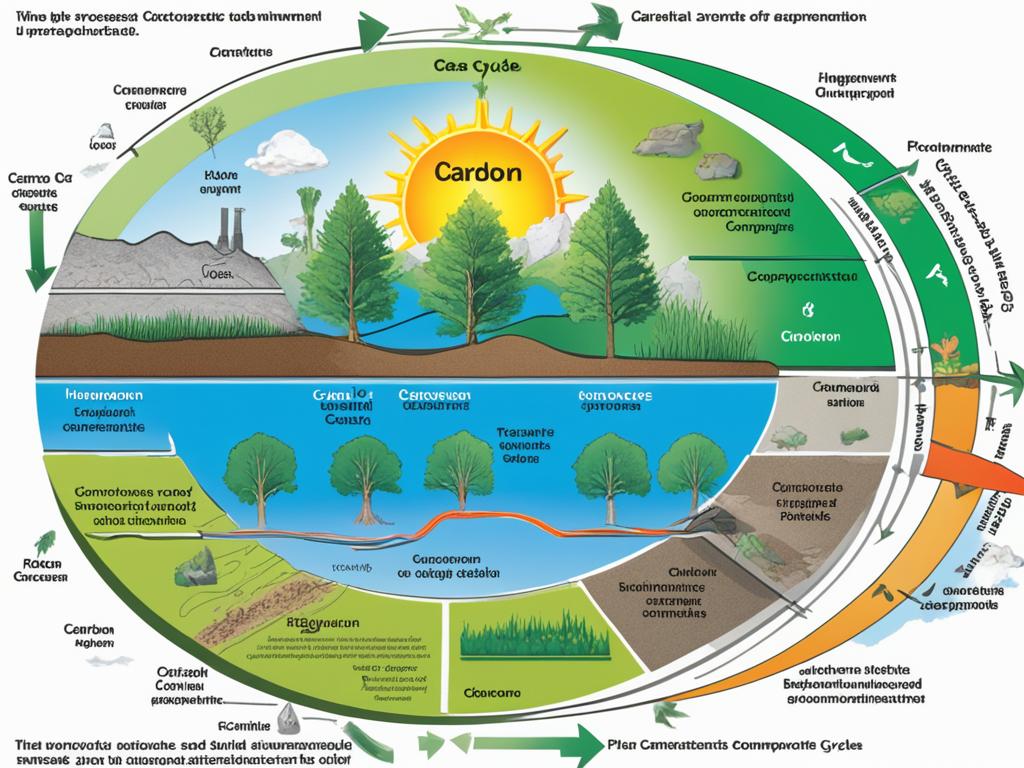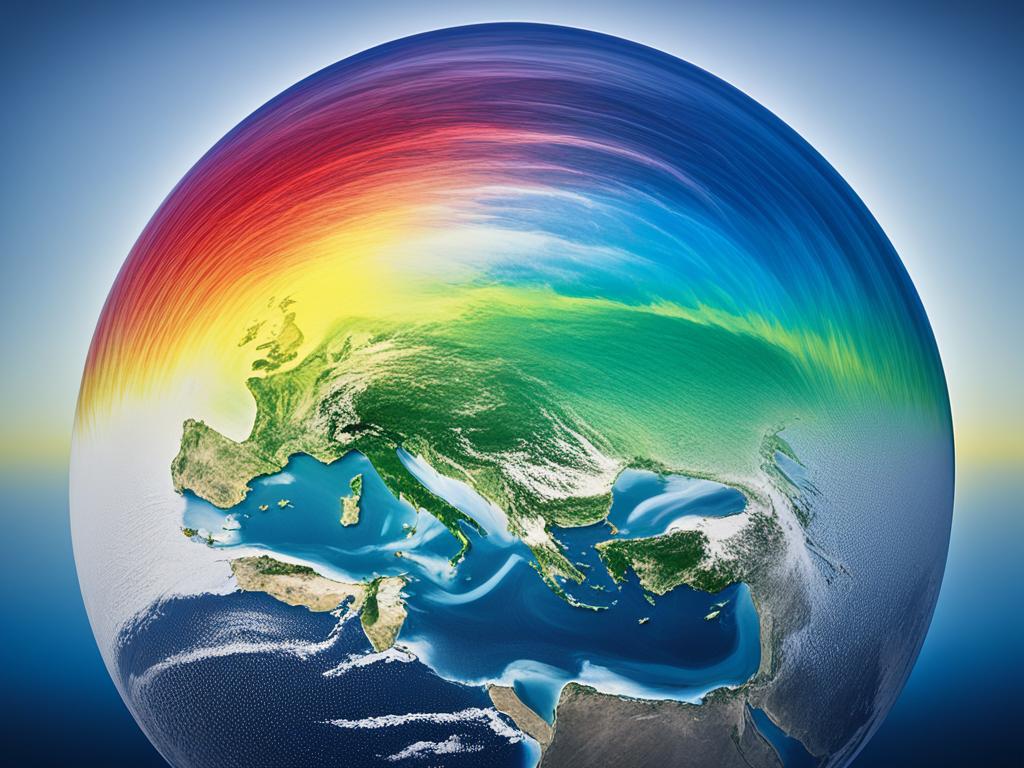The carbon cycle is key to how our planet works. It helps keep our ecosystems in balance and our climate stable. This cycle moves carbon through the air, water, soil, and living things. This process is crucial for all life on Earth. Learning about this cycle helps us aim for a future that’s good for nature.
High-level experts, including those at the National Oceanic and Atmospheric Administration, say the carbon cycle is vital. It keeps the energy balance that life needs going. What’s more, NASA and other top groups show us how messing with the carbon cycle affects our climate. They warn that our actions are making the greenhouse effect worse and changing our climate.
We must work hard to fix this. Putting carbon sequestration strategies into action can help reduce the harm we’re causing. By knowing and doing what’s right, we can protect our planet for those who come after us.
Breaking Down the Basics of the Carbon Cycle
It’s key to understand how the Carbon Cycle Processes work to see how our world deals with carbon. The Earth handles carbon in many ways, like through the air, oceans, and terrestrial carbon sinks. The U.S. Geological Survey points out that things like photosynthesis and carbon in the oceans are big parts of this cycle.

The British Geological Survey says that terrestrial carbon sinks are very important in cutting back on carbon dioxide in the air. These sinks take in carbon, especially in forests and soil. This helps balance the carbon we put out, making us think about how to use this process against climate change.
The United Nations Environment Programme thinks we should use sustainable practices to keep the carbon cycle natural. This means better ways of using land, growing back forests, and smarter farming. These ways aim to make carbon sinks work better and make our impact on the planet smaller.
When we use more sustainable practices, we can keep the carbon cycle in check. This helps keep nature in balance, support different life forms, and control the climate. So, knowing about and helping Carbon Cycle Process is key to a greener future.
The Role of Atmospheric Carbon Dioxide in the Planet’s Health
Atmospheric carbon dioxide is crucial in keeping our planet’s climate in check. It plays a big part in our environment’s well-being. With carbon dioxide rising, it’s vital to understand how it affects our climate. We need to figure out ways to keep track of these changes.
How CO2 Levels Regulate Earth’s Temperature
Carbon dioxide naturally helps control the Earth’s temperature. It does this by managing the Greenhouse Effect. This effect keeps the sun’s heat close to Earth, making sure it’s warm enough for plants and animals to thrive.
But, when there’s too much carbon dioxide from things like burning fossil fuels, the Earth gets too warm. This leads to global warming and unusual weather. It’s key to know how changes in carbon dioxide levels can disturb our climate’s delicate balance.
The Greenhouse Effect: Understanding the Balance
The Greenhouse Effect is good for our planet, but it’s getting too strong because of too much CO2. This effect is a natural way that Earth keeps warm enough for life. But too many greenhouse gases can make it too hot. NASA and others say it’s very important to keep this natural balance to support life. They warn that human actions are making the balance harder to keep.
Measuring Atmospheric Carbon: Methods and Trends
Studying how carbon dioxide changes in our atmosphere needs careful methods. The World Meteorological Organization and others use high-tech tools to keep an eye on CO2 levels. So far, the data shows that CO2 is going up a lot. This rise is largely because of factories and cities growing. It shows the world needs to work together to stop this rise.

The rise in CO2 and its link to climate change are urgent problems. We need to take quick action with policies and changes in how we live. Using good data and spreading awareness can help us lower CO2 levels. This, in turn, can slow down global warming.
Photosynthesis and Respiration: Nature’s Carbon Exchange
The Earth’s carbon cycle is greatly shaped by photosynthesis and respiration. These processes are key to strategies for capturing carbon globally and also to our basic understanding of the environment. Learning about them helps us protect our planet.
Photosynthesis turns sunlight into chemical energy for plants. This energy is stored in sugars. It not only keeps plants alive but also creates oxygen and other organic substances for all life. The Smithsonian National Museum of Natural History explains how plants use carbon from the air in this process.
Conversely, respiration helps by breaking down these sugars for energy. It releases carbon dioxide and water. The American Society of Plant Biologists states that this is important for the cycle because it puts carbon back into the air.
This dynamic exchange helps maintain the atmospheric balance crucial for life on Earth.
It’s vital to understand these natural cycles to help control carbon. The Food and Agriculture Organization of the United Nations points to farming techniques that are good for capturing carbon. These include making photosynthesis better and breathing more efficient. These practices are crucial in the fight against climate change, especially when we know a lot about the environment.
- Knowing more about the environment helps us find better ways to capture carbon.
- Good techniques can reduce our impact on the environment and make nature stronger.
- Learning about photosynthesis and respiration is key to future work that harms Earth less.
In summary, photosynthesis and respiration keep life going and help with Earth’s carbon. They are part of a natural way to deal with climate change. By learning more and putting what we know into action, we can take better care of our planet for the future.
The Human Impact: Fossil Fuel Combustion and the Environment
Today, we see more clearly the harm from burning fossil fuels. It’s making us worry about our carbon footprint and the state of our planet. Originally, industry was seen as driving our progress forward. Now, it’s a big part of the problem, adding too much carbon to the air. This upsets the natural balance and makes it hard for oceans to absorb carbon. We’re entering a time where fighting climate change is a must. Understanding the switch from fossil fuels to renewable energy is key now.
The Surge of Carbon Emissions from Industrial Activities
Our move to industrialize has brought amazing technologies and wealth. But, it has damaged our environment greatly. The International Energy Agency warns us about how much carbon we’re releasing. Using coal, oil, and gas is filling our air with greenhouse gases. It’s changing our climate for the worse and speeding up global warming.
Fossil Fuels vs. Renewable Energy: Carbon Footprints Compared
Now, we’re comparing the impact of fossil fuels to renewable energy. The U.S. Energy Information Administration shows the clear benefits of renewable energy. Things like solar power, wind energy, and hydroelectric power show us a greener future. In that future, we produce energy in ways that protect the Earth, aiming for a healthier world for all.
Policies and Protocols in Managing Carbon Outputs
There’s a big push worldwide to lessen our environmental harm. This effort focuses on cutting carbon emissions. The Paris Agreement and the United Nations are at the center. They aim to get all nations to commit to cleaner, more sustainable energy. For these plans to work, we all need to value actions that protect our environment. This means moving our economies towards greener, long-term solutions.


